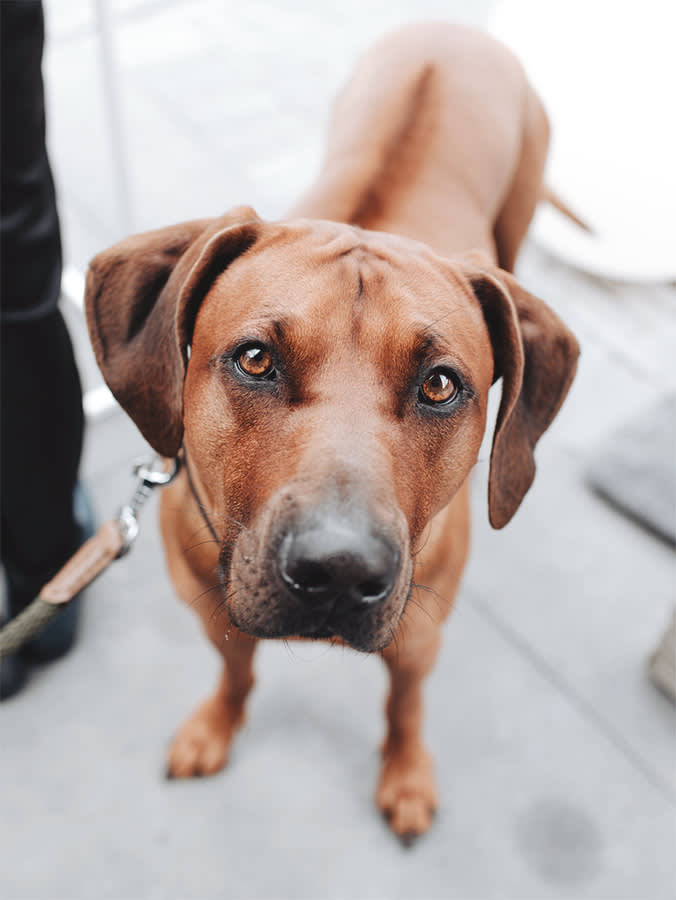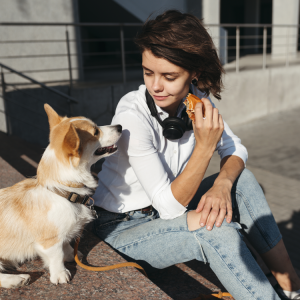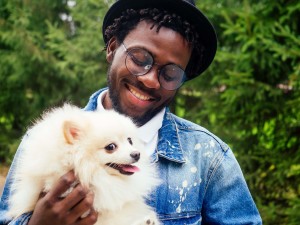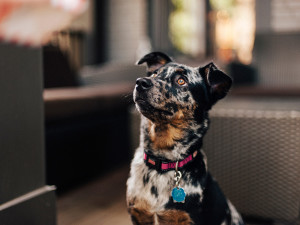
share article
If you stare into a dog’s eyesopens in a new tab long enough, some questions might come up, like: “How is one creature so perfect?” and “Is this the happiest I’ve ever been?” And if you gaze at the eyes of a hundred different dogs (first of all, congratulations), another curiosity might strike: “Why are most of these dogs’ eyes brown?”
Compared to humans, dogs don’t have much variation in their eye color (when’s the last time you saw a pup with hazel eyes?). While plenty of pups have blue eyesopens in a new tab, the great majority of dogs’ eyes are some shade of brown — though, fun fact, most dogs are born with blue eyes before melanin (the substance responsible for pigmentation) production increases.
One group of researchers suggests the lack of blue-eyed pups doesn’t come down to chance: Dogs may have been specifically bred to have brown eyes because humans perceive them as more friendly.
Domesticated dogs have darker eyes than wolves.
The study, published in Royal Society Open Science,opens in a new tab analyzed the images of 22 gray wolves and 81 domesticated dogs. The domesticated dogs were of a variety of breeds, and the wolves had various coat colors. When they compared the iris colors of the wolves and domesticated dogs, they found that “the irises of dogs were significantly darker than those of wolves,” wrote lead author Akitsugu Konno. Wolves typically have yellow eyes, while domesticated dogs’ eyes are dark brown or black.
They then found 12 photos of dogs on stock media websites and cropped the photos to show just the eyes and muzzles of the dogs. Using photoshop, they created two versions of each photo: one with yellow eyes, and one with black. Participants then looked at six images: three dogs with dark eyes and three with light (they didn’t look at two versions of the same dog). Each participant answered questions about the dogs’ presumed personalities and rated how likely they would be to interact with the dog or keep the dog.
Humans find dogs with brown eyes to be friendlier.
The researchers found that “darker eyes in dogs are linked not only to the perception of friendliness but also to immaturity,” wrote Konno. Dark-eyed dogs were rated as kind, friendly, and nonaggressive; they were also rated unconfident, dependent, unintelligent, and immature.
All these traits may cause a human to want to care for a dog. The researchers propose that pupil size may be what humans are reacting to — pupil size decreases as humans age, so we may associate large pupils (and therefore dark eyes) with babies.
Additionally, previous research has foundopens in a new tab that pupil size can communicate various social and personality signals between humans. For example, dilated pupils are associated with happiness while smaller pupils are associated with anger. People with large pupils are rated as more attractive than people with small pupils, and “ a recent studyopens in a new tab demonstrates that human participants evaluate those with dilating pupils as more friendly, attractive, and trustworthy and behave more cooperatively with them in [a] trust game,” wrote Konno.
Brown eyes may make it more difficult to see changes in pupil size, which might make even an angry dog seem less threatening to humans; people may also think a dog with dark brown eyes has larger pupils than they really do, leading them to find the pups more trustworthy.
Interestingly, the study did not find that a participant’s acceptance of the dog (their likelihood to approach and adopt the dog) depended on eye color — eye color is just one of many factors that humans react to when determining whether or not they feel kinship with a dog.
Dogs have brown eyes for other potential reasons.
While it’s possible that humans artificially bred dogs to have brown eyes many years ago, a variety of other explanations hold equal water. Wolves could have evolved lighter eyes to make pupil communication more clear between them in the wild, while this became less and less necessary for dogs who were living with humans.
Environmental factors could also contribute; wolves mostly live in the north, so melanin may have increased for ultraviolet protection as domesticated dogs moved into the south. Lastly, more recent breed standards could be resulting in a greater number of brown-eyed dogs.
Regardless of the exact reason, the researchers feel confident that the difference in eye color occurred during the domestication process, which means it’s likely that human breeding practices played a hand. So the next time you’re gazing into some dark brown doggie eyes, you can thank your puppy-domesticating ancestors for the adorableness before you.
Or, if the dog happens to have light eyes, you can let them know how extra-special they are. Either way, give that pup’s chin a scratch — and try not to judge them by their eye color. We might have more natural biases than we think.
References:

Sio Hornbuckle
Sio Hornbuckle is a writer living in New York City with their cat, Toni Collette.
Related articles
![Man hugging his fluffy white dog happily]() opens in a new tab
opens in a new tabChemistry Between People and Dogs Is Real (It’s Science)
How the “love hormone” oxytocin connects us with our pups.
![]() opens in a new tab
opens in a new tabTo Cry Is Human — and Apparently Canine
Time to whip out The Notebook for a little doggy movie night.
![Wolfdog (Wolf/Dog Hybrid) don't always make good pets]() opens in a new tab
opens in a new tabDo Wolf Dogs Make Good Pets?
Experts say these hybrid animals should be wild and free.
![Happy young woman with her back dog in front of a green garage door in a street in Paris France.]() opens in a new tab
opens in a new tabWhy You Should Adopt a Black Dog
Sadly, black dogs are adopted less than pups with lighter coats. Here’s everything you should know about “black dog syndrome.”
![A woman walking 5 dogs on leashes outside.]() opens in a new tab
opens in a new tabBreed Does Not Equal Behavior—Here’s Why
A new study found that a dog’s breed accounts for less than 10 percent of their behavior.
- opens in a new tab
Do Dogs Understand Our Words?
Say What? A look at the types of words that dogs understand.







